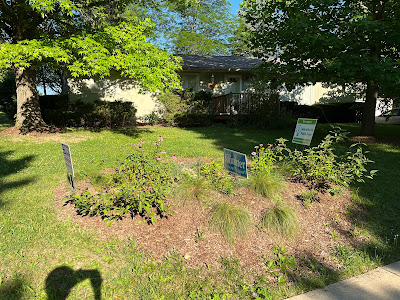Back when I was writing and performing climate theater, it was a very useful exercise to view things like the earth or the economy as characters. Upon reflecting on what sort of character a front lawn might be, I realized that the expanse of mowed grass is much like a trophy wife for the House. Expected to be well manicured, passive and forever young, the front lawn serves no other purpose than to present a flattering view of the House to the public. In return for its submissiveness, the front lawn is allowed, and in fact expected, to remain perpetually idle. Any shift away from bland formality, such as a wildflower meadow or, heaven forbid, a vegetable garden, would be unbecoming and steal attention away from the House. It seemed to me the front lawn could benefit from a good turf therapist who could help her sort through how she ended up in such a one-way relationship, and from that developed a monologue called Turf Therapy.
News from the preserves, parks and backyards of Princeton, NJ. The website aims to acquaint Princetonians with our shared natural heritage and the benefits of restoring native diversity and beauty to the many preserved lands in and around Princeton.
Wednesday, July 27, 2022
The Evolution of the Front Lawn in Ann Arbor, MI
Monday, July 04, 2022
What's Bloomin' in the Barden -- Early July
An effort to document everything flowering in the Botanical Art Garden at Herrontown Woods on one day in June (the 26th):
Black-eyed Susan in the Veblen Circle surrounding the gazebo.BeebalmFringed loosestrife is a shy native wildflower, pointed downwards, but is not shy about spreading.
The tiny flowers of tall meadowrue make clouds of white in the Barden, sometimes rising to ten feet. I've found it growing wild in Princeton in only a couple places, but it grows well in a garden.
A few sundrops are hanging on, with their x-shaped stigma. This is an easy flower to grow, spreading a little but not too much.
Narrow-leaved mountain mint is a native wildflower that appeared spontaneously in the Barden. It's a fairly common wildflower of meadows in the Princeton area.
Daisy fleabane was blooming weeks ago and is still at it. There are two species.
Common milkweed has spread rapidly at the Barden. I just met some Herrontown neighbors who grow milkweed, and their kids have already found two Monarch caterpillars that they adopted and grew into butterflies.
moth mullein,
(moth mullein's distinctive buds)
wooly mullein, which can spread by seed quite a bit but we allow a few to grow for their dramatic shape and the velvety feel of the leaves,
silky dogwood,
and elderberry.
We're being very encouraging of sedges at the Barden, planting them in swales where they get plenty of moisture. They reach a peak of lush, grassy beauty in late spring, and each species has a different shape to the clusters of seeds. There are many species of sedge. I'm going to say this is Carex lurida, the sallow sedge.
I'd call this the morning star sedge, Carex grayi.
Friday, July 01, 2022
Bluebird of Happiness -- Evicted by a House Wren!
Boy, was I naive. Last year we worked with a local girlscout troop to install some birdhouses at Herrontown Woods, and it was such a delight this spring to see bluebirds taking an interest in one of them, just up from the Veblen House. I'd walk by, listening to their merry chatter, and remember that I had once again forgotten to bring along a camera with a good enough zoom to photograph their comings and goings. Surely there would be time to catch a charming shot of their auspicious presence.
One day, however, a couple weeks ago, we were working on the Veblen House grounds, the bluebirds serenading in the background, when I noticed a different sound intruding. It seemed vaguely concerning, but I was so focused on my task that I didn't stop to take note of what was happening.By afternoon, however, I sensed something had clearly changed, and dropped what I was doing to go over and have a look.
I had heard of wrens skewering other birds' eggs with their beaks, but hadn't thought much of it. This looked like an outright eviction. It was time to find out more. A website called sialis.org quickly popped up on the internet. Bluebirds are so loved they have their own website, named after their latin name, Sialia sialis.




































